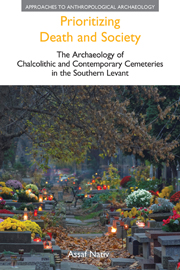 Prioritizing Death and Society
Prioritizing Death and Society from Part II - Chalcolithic cemeteries
While the cemeteries between the Alexander and Qishon streams consist of a single cave each (see Chapter 4), farther south, the cemeteries consist of multiple caves. Most cemeteries are found between the Yarqon and Ayalon streams and appear to dwindle as one moves south. While the decreasing density of cemeteries may faithfully represent spatial patterns of the Chalcolithic funerary landscape, it may also be due to differences in the intensity of development work conducted in these areas, as these operations are responsible for the discovery of most of these sites.
Nevertheless, there is reason to suspect that the cemeteries farther to the south may differ from those in the “core area”, at least as it is currently manifested in the maps. This is particularly the case for Horbat Qarqar (Fabian 2012a), which, although consisting of multiple caves, appears to be organized along lines inconsistent with most cemeteries discussed here. This point will be partially clarified in this chapter and further elucidated in Chapter 8.
Altogether, eleven multiple-cave cemeteries (a total of forty-nine caves) comprise the dataset (see Table 5.1), excluding Horbat Qarqar and two cases of single-cave cemeteries, to be discussed in Chapter 8. Like the northern cemeteries, they vary considerably in the quality of data available for discussion. Inconsistencies in preservation, excavation methods and publication similarly render their treatment difficult. However, their multi-componential structure makes it much harder to assess just how fragmentary the information at our disposal is.
To save this book to your Kindle, first ensure [email protected] is added to your Approved Personal Document E-mail List under your Personal Document Settings on the Manage Your Content and Devices page of your Amazon account. Then enter the ‘name’ part of your Kindle email address below. Find out more about saving to your Kindle.
Note you can select to save to either the @free.kindle.com or @kindle.com variations. ‘@free.kindle.com’ emails are free but can only be saved to your device when it is connected to wi-fi. ‘@kindle.com’ emails can be delivered even when you are not connected to wi-fi, but note that service fees apply.
Find out more about the Kindle Personal Document Service.
To save content items to your account, please confirm that you agree to abide by our usage policies. If this is the first time you use this feature, you will be asked to authorise Cambridge Core to connect with your account. Find out more about saving content to Dropbox.
To save content items to your account, please confirm that you agree to abide by our usage policies. If this is the first time you use this feature, you will be asked to authorise Cambridge Core to connect with your account. Find out more about saving content to Google Drive.